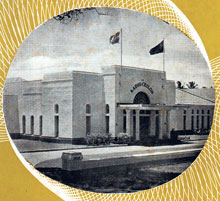Radio equipment
salvaged from a captured German ship and turned into a small transmitter by Central Telegraph Office (CTO) engineers gave the start for the setting up of a broadcasting service in
Sri Lanka way back in 1923. Gramaphone music was broadcast from a tiny room in CTO using the small transmitter. Barely three years later, a regular broadcasting service was inaugurated.
The service was gradually expanded until a
separate government department for broadcasting was set up on October 1, 1949, a little over one and a half years after Independence. A concert studio was opened at the Ceylon University College in 1926 and acoustically treated studios and an engineering control room were installed at Torrington Square in Colombo in 1927.
 |
| Torrington Square office |
The year 1930, saw the installation of a separate transmitter. Four years later a Wireless Broadcasting Advisory Board was set up and experiments were started with a short wave transmission to achieve better reception outside a 40-mile radius from Colombo.
A Receiving Station for the reception of Empire
programmes was also
constructed.
Meanwhile, engineers continued with the
pioneering technical work and a 3.5 – 5 KW medium wave transmitter designed by a local engineer was installed in 1937.
By 1940 the number of radio licenses reached 10,000.
With World War II
escalating, the Royal Air Force occupied the Torrington Square premises and broadcasting facilities were shifted to Cotta Road (now Dr. N. M. Perera Mawatha), Borella in 1942.
In 1947, work on the present building at Torrington Square with facilities for a modern broadcasting station commenced. It was completed in September 1949, just before the setting up of the Department of Broadcasting under the designation 'Radio Ceylon' (those were the days when the country was called Ceylon). The head of the Department was designated Director-General and the first holder of the post was John N. Lampson.
During the war, the British Services had opened the SEAC (South East Asia Command) radio station with a powerful 100 kilowatt transmitter at Ekala, 13 miles from Colombo. In March 1949, the transmitter was given over to the Government and the SEAC station was absorbed in the Government broadcasting system in December 1949.
The Commercial Service of Radio Ceylon was started soon after the Department was established. Voice of America was allowed facilities to beam broadcast from here and their transmitters and equipment were made available to Radio Ceylon when not required for their own programmes.
From time to time, a number of committees and royal commissions were appointed to look into broadcasting. The first was the Special Committee appointed under the chairmanship of Kanthiah Vaithianathan to "consider broadcasting in Ceylon in all its aspects as well as other points which bear a relation to the general question."
The N. E. Weerasooriya Commission (April 1953) made detailed recommendations for the development of Radio Ceylon which had not been implemented. This promoted the next Commission, H. A. J. Hulugalle Commission (May 1966) to comment that the by-passing of the various Advisory Committees appointed as recommended by the Weerasooriya Commission "has contributed, in no small measure, to the
lackadaisical state of Radio Ceylon."
The Hulugalle Commission concluded that Radio Ceylon cannot function efficiently or improve its standards to the level which the public is entitled to expect, while it remains as a government department subject to the usual
financial; and administrative regulations. The Commission recommended that it be placed under a Corporation consisting of five persons of high calibre appointed by the Governor-General on the recommendation of the Prime Minister.
In 1967, the Department of Broadcasting was transformed into its present statutory form of a state corporation by the Ceylon Broadcasting Corporation Act. No 37 of 1966, thereby assuring increased
autonomy and flexibility in the operations of the new organization.
The organization acquired its present name, Sri Lanka Broadcasting Corporation (SLBC) with the transition of the state into the status of Republic of Sri Lanka on May 22, 1972. SLBC has since
continued in the same legal status as a state
corporation, and is
currently listed under the scope of the Ministry of Information and Media.
|

